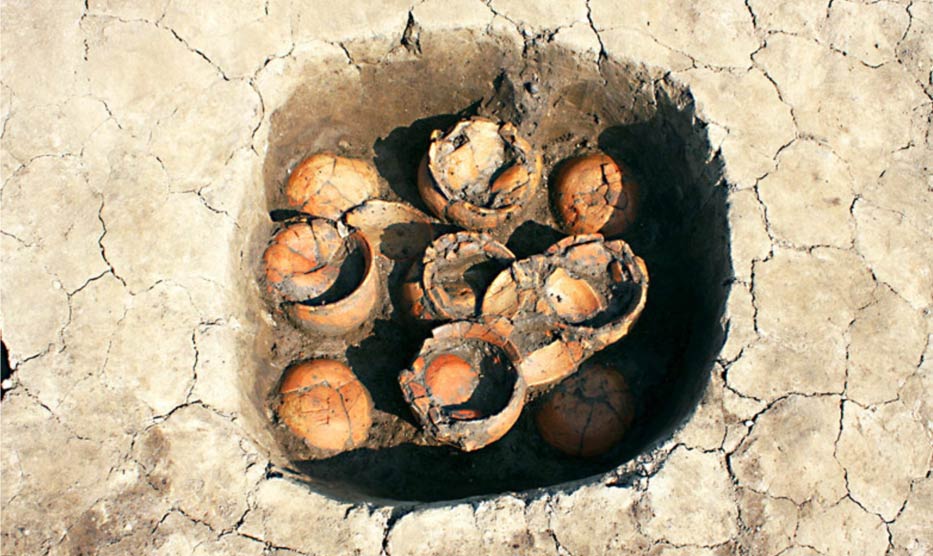Rare ritual jars found buried under ancient ruins in Japan intended to purify, bring eternal youth
Japanese archaeologists have made a surprising discovery beneath ancient ruins in Japan. An arrangement of coin-filled clay pots aligned to the cardinal directions have been found buried beneath the ruins of a building, suggesting to experts that this may have been part of an ancient Buddhist purification ritual, bringing wealth, good luck, and longevity.
According Japanese news source The Asahi Shimbun, the jars were excavated at the Tehara ruins in Ritto, Shiga Prefecture. The lidded clay jars were found in a shallow hole, and each of the five measured 14 cm in diameter and 12 cm high. They had been carefully arranged in a cross shape, pointing north, south, east and west. The Ritto city board of education says this placement reveals they were used as an esoteric rite in the Buddhist tradition.
The five “Fujushinpo” coins found in each of the jars were forged in 818. A peach seed was also pulled from one of the jars. Along with the pots, “Hajiki” (Haji) clay plates were also buried at the four directions in the hole, and located around the perimeter were additional pots containing “Wadokaichin” and “Jingukaiho” coins. The age of the pots and the dating of the various coins suggest to researchers that the ceremony and purification was carried on for decades.

Hajiki from the Kōriyama Site, Sendai, Miyagi prefecture, Japan. These unglazed earthenware plates were used for everyday purposes as well as in rituals. They can be found in ancient Japanese tombs, and help researchers date archaeological sites. Public Domain
Archaeologists believe that the buried ritual goods signify the building they were under may have been a public office or house for an official or important local leader.
Archaeology News Network reports that archaeologist and director of the Gangoji Temple Research Institute of Cultural Property, Masayoshi Mizuno says of the find, “In Buddhist site-purification rituals, noxious vapors are purged by placing Buddhist images at nine points around a square, including the center. This indicates there used to be an important building there."

Silver Wadōkaichin coin, 8th century, Japan. Wikimedia, (CC BY-SA 3.0)
The placement of the jars as well as their contents reveal to researchers much about their purpose.
Towao Sakaehara, director at the Osaka Museum of History and an expert in Japanese ancient history, tells The Asahi Shimbun, “The pots that contain offerings appear to have been deliberately positioned in a central location and the four points of the compass. They seem to have been treated with great care.”
He continues, "They were likely buried in the hope of prosperity for the building owners and others, given that ancient coins bearing such words as ‘tomi’ (wealth) and ‘kotobuki’ (congratulations), as well as a peach seed believed to clear away bad vapors and bring perpetual youth and longevity, are encased.”
Similar ritual purification and warding objects have been discovered at other archaeological sites, such as the ruins of the ancient city of Sardis, in modern-day Turkey. Lifted from under the floorboards of a 2,000-year-old dwelling, archaeologists found pottery containing small bronze tools, coins, and a remarkably intact eggshell. Experts believe the items were part of an ancient ritual meant to ward off evil and protect against earthquakes, writes LiveScience.

Pots from ancient Sardis holding bronze instruments, coins, and a remarkably preserved eggshell from 2,000 years ago. Credit: ©Archaeological Exploration of Sardis / Harvard University
The ancient ritual pots and coins are thought to be the first of their kind found in Japan, and it is hoped they will shed light on the lives at Tehara, and the Buddhist rituals of the historical Heian period (794 – 1185).
Featured Image: Five clay pots and four plates pointing to the cardinal directions excavated at the Tehara ruins in Ritto, Shiga Prefecture, Japan. Credit: Ritto City Board of Education
By Liz Leafloor


















